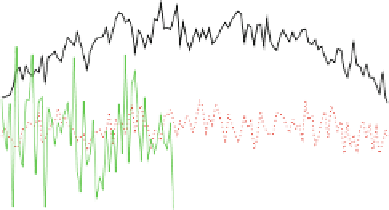Environmental Engineering Reference
In-Depth Information
ˉ
R
=1-r/r
c
ˉ
R
=(1-r/r
c
)
1/2
ˉ
R
=const.
2
1.9
1.8
1.7
1.6
0.2
0.4
0.6
0.8
z/D
Fig. 17
Temperature profile for different DPD weight functions in a Couette-flow simulation. The
walls are moved at
v
w
=
3
˃/˄
and the channel width is
D
w
=
30
˃
, with a shear rate of
ʳ
=
0
.
3
˄
−
1
.
The usual choice of weight function fails to keep a constant temperature across the channel (
dark
full line
). Constant weight functions
ˉ
R
2
D
=
ˉ
=
ʘ(
R
c
−
r
)
are able to give a temperature
profile at the defined temperature (
dashed line
).
ʘ
is the Heaviside function and
R
c
the cut-off of
the forces. Adapted from Pastorino et al. (
2007
)
This problem of temperature conservation shows up for hard potentials at very
short cut-off radius and strong flow conditions. This by no means limits the use of
DPD, taking into account the solutions we propose in this section.
6 Concluding Remarks
In this contribution we have reviewed the Dissipative Particle Dynamics method,
as a useful simulation technique to study soft matter systems in equilibrium and
under flow. We emphasize the role of DPD as a thermostat that takes into account
correctly the hydrodynamic correlations in the system, unlike many thermostats used
in molecular dynamics. This is a desired property to study stationary flows at the
mesoscopic level with coarse-grained models of the molecular degrees of freedom.
We give examples of the use of the DPD thermostat with soft potentials and hard
potentials for polymeric liquids, polymer brushes and simple liquids. In equilibrium
simulations with soft potentials, we also illustrate the use of DPD with Coulomb
interactions to model poly-electrolytes, confinement and constant chemical potential
simulations in the Grand-Canonical Ensemble (
VT
).
We show that DPD is suitable for generating simple flows like Couette and
Poiseuille flows and having access to the main velocity of density fields, charac-
teristic of hydrodynamic theories but also to the boundary conditions and dynamics
coefficients such as diffusion coefficients or viscosity. The latter are not imposed to
the system, but obtained from the simulation itself, for given molecular model and
flow conditions. In the studied cases the goal is simulating the system at constant
μ













































Search WWH ::

Custom Search